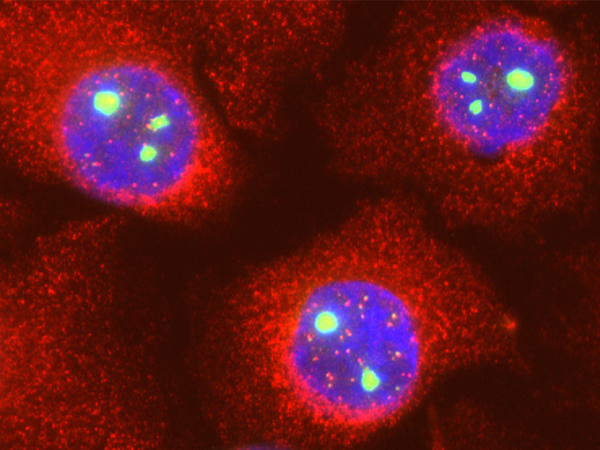 Over the Christmas break I hope to read at least one Montalbano detective story, plus a Scandinavian crime story or two. Incidentally, the Montalbano series is very good, light, reading. It is also set on Sicily, and reading about somewhere warm and sunlit is nice at this time of year. I also want to read about Cajal bodies.
Over the Christmas break I hope to read at least one Montalbano detective story, plus a Scandinavian crime story or two. Incidentally, the Montalbano series is very good, light, reading. It is also set on Sicily, and reading about somewhere warm and sunlit is nice at this time of year. I also want to read about Cajal bodies.
A Cajal body does rather sound like something Inspector Montalbano comes across in chapter one, but in fact they are structures inside the nuclei of our cells. They are are the small red dots inside the blue circle in the image at the top. Blue indicates DNA so the blue circle is the nucleus of a cell – where the DNA is. There are also red dots outside the nucleus because they see the Cajal bodies by adding a red fluorescent tag to a protein that is found in Cajal bodies. But this protein is also found outside the nucleus of the cell, in what is called cytoplasm, and so we see red dots there too.
Also, inside the nucleus you can also see 2 or 3 larger structures, these are called nucleoli. There are also other structures that are not visible in this image.
The bottom line is that there a whole bunch of structures in the nucleus, i.e., the nucleus is organised into domains with different functions. The nucleus is like a city. A city may be organised into a restaurant district, suburbs, a banking district etc. A nucleus is organised into districts tp, for example, the nucleolus, where the process of making ribosomes is concentrated. Ribosomes are where proteins are made (when they are exported from the nucleus).
On the face of it, making all the ribosomes in one place is sensible. You can concentrate the ingredients there for them, and make them faster. A bit like having a restaurant district, where people can go and choose a restaurant. In both cases it makes sense to concentrate things in a small area, not spread them out thinly.
But this a purely qualitative explanation. It leaves many questions unanswered. For example, making ribosomes requires dynamic energy-consuming processes. Do these processes help promote nucleolus formation, or do they tend to break nucleoli apart, and so need to be resisted by other processes? Maybe my Christmas reading will help me here, and ultimately I’d like to write down some equations. But that’ll only be in 2012.
